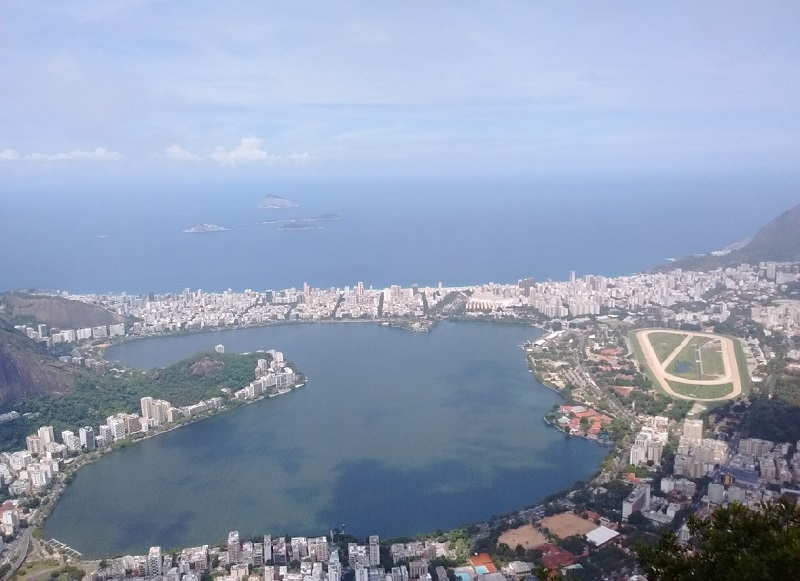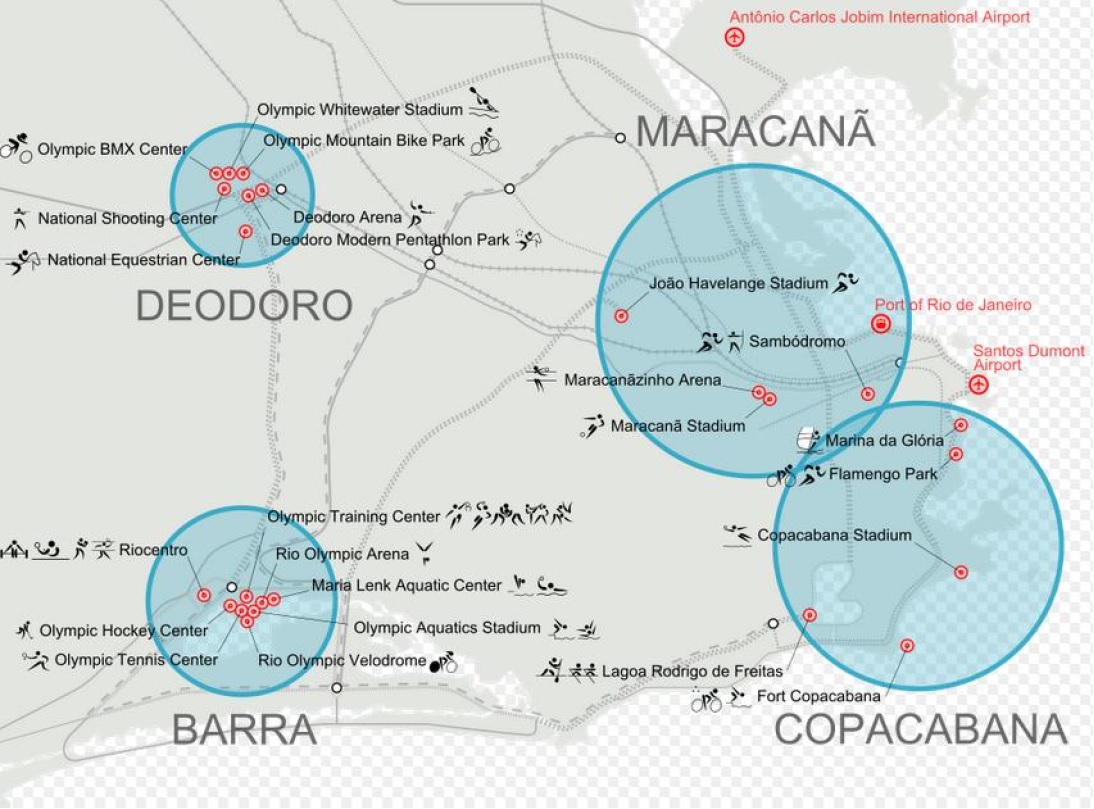Brazilian Perspectives
Leonardo Poletti - Architect and Urbanist, Specialist in Civil Construction - Partner of the Brazilian Offices 3C Architecture and Urbanism and Entre - Architecture of Solution
A look at the legacy of the Olympic Games in Rio de Janeiro
November 9th, 2017In 2009 the city of Rio de Janeiro was chosen as the host city for the 2016 Olympic Summer Games, beating Madrid, Tokyo and Chicago in the final vote. It was a reason for pride and celebration for the Brazilian people who, at the time, lived in a heady optimistic atmosphere fueled by good results from the domestic economy. At that moment there was certainty that Brazil was finally moving in solid steps towards expected future prosperity.
Having the honor of hosting the Olympics reinforced this impression. Rio would have the opportunity of undergoing transformations similar to Barcelona in 1992, or like London was going through. By the way, as we had the opportunity to see how the British were preparing for the games, the policies that were being implemented in the city, the legacy being built and finally the result both in the organization of the event and in the performance of the British athletes, our own expectations of going through the same experience also grew.
The propaganda sold by the Brazilian Government and the Olympic Committee (COB) before and during the games was that the legacy that would be left in Rio would radically change its reality. The symbolism of the Olympic spirit was exhaustively used as the catalyst for the new moment that our nation was entering. And Rio de Janeiro, recognized worldwide for its natural beauty, could indeed be called the Marvelous City in every respect. The planned works would promote a long-awaited revolution in public transport through the implementation of a mobility policy. There would be the pacification of violent communities through urbanization of the slums and effective actions to combat drug trafficking, which would reflect in the safety of the entire population. In addition, structures would be built that would allow the social inclusion of young people in situations of social fragility through Olympic sport. All based on respect for natural resources, promoting urban development following the most rigorous environmental sustainability principles.
In 2012, once the London games were over, we turned our gaze more closely to our own preparations and started to project how the games would look like on Brazilian soil. It was then that we began, gradually, to return to our reality. While in the British capital we observed the previously decayed and degraded Stratford area become a large and qualified public space for leisure and sport, here, the key constructions to host competitions and promote improvements in public transport were being delivered very slowly. Worse, projects such as sewage collection and treatment to help clean up the Guanabara Bay and the Rodrigo de Freitas lagoon, which would also host competitions but above all carried the symbolism of being the great actions related to the environmental legacy of the games, were increasingly doomed to being left on paper. Unfortunately that was what actually happened.
Rodrigo de Freitas Lagoon
At this point it is important to draw a parallel between the cities that hosted the last two Olympic games and the different way in which they approached their preparation. While in London the focus was to revitalize a specific area - the Lower Lea Valley - and to concentrate there the main part of the structures to host the games, in Rio de Janeiro it was chosen to spread the structures around several parts of the city. The choice of the venue for the construction of the Olympic Park, where a lot of the arenas of competitions were erected and also the Village of the Athletes, generated the most controversy. This is because this venue is located in an area far from the city, which necessitated the construction of a heavy network of infrastructure that passes through a large urban void that serves an insignificant portion of the inhabitants of Rio de Janeiro. To give you an idea, the expansion of the subway line to this area consumed 25% of all funds invested to carry out the games. And to this day some of the stations have still not been delivered. It is difficult not to judge this investment as disproportionate, even though the benefits related to urban mobility that this intervention brought to the West Zone of Rio are undeniable.
Venue map prepared by Felipe Menegaz
A comparison between the two approaches allows us to identify the great difference in the legacy left by the Olympics in the two cities. In London, as soon as the games were concluded, the British capital already had a consolidated plan to conduct the Olympic legacy. The region that hosted the competitions gained an efficient network of transport infrastructure and new buildings. The Olympic Park has been renovated and opened to the citizens, offering them leisure options and sports facilities, although a good part of them demand tickets to be used. Still, negative points are identified, especially with regard to the high real estate valuation that the region has gone through, which has put pressure on former residents to leave the region. The promise to keep half the new housing built in the "economically accessible" category has not been fully met. Consequently, the sense of community that until then existed in the region was lost.
In Rio de Janeiro the approach was much more ambitious. In a city that presents the most diverse and serious deficiencies of a quality public service, the option to scatter competitions to different parts of the city could be understood as the most appropriate, after all it could benefit a larger portion of its population. The big question is that the problems that the city presented (and in most cases still present) were really chronic, and therefore it was imperative to build new, complete and complex infrastructure networks that demanded astronomical sums of money. And this money was almost always withdrawn from the public coffers, which by this time were no longer as full as they had been in 2009. This scenario put Rio's organizing capacity to the test to leave the city in a position to receive the Games. Unfortunately the result was works completed in haste, some of which are still unfinished, many of which today are abandoned, practically all of them overpriced. And that, so far, have not brought significant benefits to the most deprived part of the Rio`s population.
Of course the Olympic Games in Rio de Janeiro did not leave only bad examples. Even before being chosen as a host city, globally recognized social inclusion programs were implemented there. The "Favela Bairro" and "Rio Cidade" (Slum District of Rio City, literally translated) programs, idealized by the architect Luiz Paulo Conde, who in 1995 was the municipal secretary of urbanism, promoted transformations in several poor communities of the city, besides urban requalification interventions in the so-called "formal city". Conde never hid his desire to transform Rio into an Olympic city and, in addition to promoting social well-being for the most needy population in the city, these programs were thought of as a way to show the world the capacity of Rio to overcome its problems, thus deserving of receiving the biggest sporting event on the planet.
As part of the effective process of the city`s preparation to receive the Olympic Games, we can cite the case of the central and port area of Rio de Janeiro. Until then completely degraded and abandoned, it underwent a revitalization process, with the installation of new museums and tram lines, among other actions, which promoted a reappropriation of this area by the population of the city. It should also be mentioned that new BRT and subway lines promoted undoubted gains to the urban mobility. Some of the structures of the mounted arenas will be dismantled and reconstructed in new places, turning into public schools. The pool in the region of Deodoro should also be open to the public, becoming a leisure option for the low-income population residing on the site. The offer of rooms in the city`s hotel chain more than doubled in this period. In addition, it cannot be omitted that the period of the games was a great party, which attracted millions of tourists from all over the world, heating the local economy. We can also cite the good performance of some Brazilian athletes that were trained in programs that promote social inclusion through sport.
Tomorrow's Museum (Projected by Santiago Calatrava)
Looking only from this perspective it could be said that the Olympic Games left a positive legacy to Rio de Janeiro. But it is extremely difficult to separate the analysis of the Olympic legacy from the corruption scandals that began surfacing after the Games ended. In the last few months the Brazilian people have had daily access to the news that confirmed the frauds, bribes and superfluous works of all kinds that occurred during the preparation of the Games. In addition, it is clear that a good part of these projects were conceived not for the well-being of the people of Rio de Janeiro, but were mainly aimed at meeting the interests of large construction companies and corrupt politicians who got millions of dollars diverted from overpriced projects. We can still take into account the evident process of real estate speculation in areas that have received substantial works, benefiting certain groups of private investors. Recently the president of the COB was arrested. Among his undeclared possessions consisted of 16kg in gold bars ... Yes, gold! There is nothing more emblematic, considering what this element represents for Olympic athletes. And this "award" was the result of their involvement in criminal negotiations that began even during the process of choosing the host city in 2009, and which in fact became more profitable when the works of the Olympic facilities and infrastructure of the city began to be carried out.
Before the president of the COB's arrest, the former governor of the state of Rio de Janeiro, Sergio Cabral, was arrested, as well as numerous members of his team and businessmen who were attached to him. There are several charges against Cabral, some of which are related to fraud in the choice of Rio as the host city, as well as diversion of public resources in the execution of the structures to host the games. The current reality is that the state of Rio de Janeiro is bankrupt, with no resources to invest in schools, hospitals, security or even to pay the salaries of its public employees.
The opening ceremony of the Olympics in Rio had a moment of enormous symbolism, where the athletes deposited in totems that formed the design of the Olympic arches the seed of 13 thousand trees, that later would be planted in one of the places of the competitions and there would form the "Forest of Athletes ". Believe it or not, the seedlings of these trees have still not been planted, they are being kept in a greenhouse and are not expected to be taken to their final destination. This may be considered a good portrait of the Olympic Games in Rio de Janeiro: an event promoted from excellent ideas, but eventually lost through the process by the mismanagement of those who were responsible for it. Yet, just as there is still hope that these trees can overcome the bureaucracy and inefficiency of Brazilian public power and actually grow and flourish, there are good examples that the Olympics allowed them to be planted in Rio de Janeiro. And in the same way, there`s still the hope that these examples will overcome the endemic practice of corruption and political neglect that have long chastised the Brazilian people, grow strongly and continue to sprout spontaneously not only in Rio, but in all Brazilian cities.





